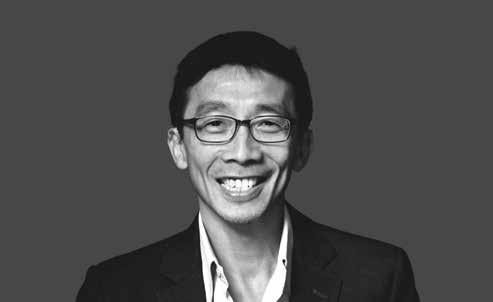


could be seen working in unison. While Betsky regards SCDA as a “ruthless and effective scavenger of whatever organizational principles” are deemed appropriate for the situation at hand, van Schaik observes how “messy reality is edited out” in our work; he states that our “idealism drives an architectural toolkit,” comprising “orthogonal relationships between literal and phenomenal transparency of horizontal and vertical planes, the floating of rectangular volumes and tabula rasa recasting of the ground and water planes, and the creation of over-sailing sky planes.” 3, 4
Both authors may be right in some way, I suspect. Certainly, SCDA was born as an amalgamation of movements and multiple localities, but it is also a consistent response to the plurality of demands and externalities that pervade commissioned work today.
Having designed single-family residences and high-rise towers, cultural institutions and commercial properties, a persistent interest in spatiality becomes clear in the range of work. In fact, as is evident in the following pages, clear traces of the spatial principles we experimented with in early residences can be found in our multiunit housing structures.
In examining our projects—completed, on the drawing boards, and those that have remained as sketches and ideas—I would propose that our work is intentionally not about singular definitions. Perhaps this approach is rooted in my education as an architect during an academically “permissive” environment in the 1980s, a moment defined by pluralistic tendencies, when we all found excitement and opportunism in a promiscuity of thought. I have certainly always found labels—especially codifications such as
“classicism,” “regionalism,” and “tropicality”— to be more restrictive than liberating. Rather, as van Schaik rightly assessed, we believe in the “architectural toolkit.” Our work is about building on a spatial vocabulary, a language rooted in space, proportion, material, light, and structure. It is the unifying thread weaving through the many commissions that SCDA has realized, in varying types, forms, and locales. It is a belief in a rulebased set of principles or kit of parts that can be deployed and composed.
In this book, we seek to explore our individual spatial vocabulary, particularly as it relates to high-rise residential projects. By extension, we pose a question central to architecture at a larger scale: how can we understand the contemporary fundamentals of high-density residential architecture? Fundamentals, by definition, are also not singular; they are not exclusively regional or global; not classical or modern. They are never restrictive as they are merely a starting point. Architecture fundamentals must be both timeless and contemporary, stable and evolving. Such fundamentals express a belief in the potential of a universal architecture based on humanity rather than formal expression.
Notes
1. Adrian Forty, Words and Buildings: A Vocabulary of Modern Architecture (New York: Thames & Hudson, 2000), 256.
2. Aaron Betsky, “The Suspended Architecture of Soo Chan,” The Architecture of Soo Chan (Melbourne: Images Publishing, 2004), 8.
3. Be tsky, “The Suspended Architecture of Soo Chan,” 6.
4. Leon van Schaik, “Foreword,” SCDA Architects II (Melbourne: Images Publishing, 2013), 13.
First published in the print edition of With Reference, 2022, with the headline “Notions of Space” and edited by
architecture is not merely about creating structures but about crafting experiences.
Small groupings of high-rise towers scatter across the urban site in La Cadiere Lake City. The angled positions of the buildings and the meandering lines of the interior roads break any recognizable grid. Their dispersed arrangement around the central Yixin Lake suggests an organized chaos. The low-rise art center tightly embraces the perfectly curved water’s edge. The master plan centers on a spatial rather than a programmatic narrative. It is at once soft and angular, sprawling and intimate, with a designed ground plane that outshines the design of the vertical structures. Each residential high-rise is set within its own landscaped footprint with tiered gardens and accented with water elements. This is the scene of urban engagement, a nature-forward microcity designed within the larger fabric of Chengdu, China’s fourth-most populous metropolis.
Whereas compositional stamina shines in Chan’s planimetric design, in section, his compositions take on a participatory dimension. Rather than imposing a rigid spatial prescription, he invites moments of improvisation, encouraging occupants to (re)interpret and engage with space freely. We can recognize the echoes of a derived ethos toward urban exploration, envisioning scenes where inhabitants wander through these landscaped realms, guided by their instincts toward carefully designed attractions—a planted courtyard here, a water feature there.
Geometric precision, an unwavering thread woven throughout every facet of SCDA’s designs, serves as the robust framework that accommodates the playful exploration of sectional variations. The deliberate orchestration of shifting ground planes introduces a dynamism and purposeful departure that breathes vitality into the landscapes, fostering an organic and layered experiential narrative that provokes an emotional response.
This is perhaps best seen in one of Chan’s now “classic” high-rise projects, SkyTerrace@Dawson. Here, spatial tensions are elevated by the direct interplay between the towers’ monolithic form and their green site. The landscape travels up the buildings, suggesting that it’s only a matter of time before it is overgrown completely.
In these larger scale projects, where the compositional tensions are amplified, buildings
don’t stand as individual units but form a collective, an arrangement filled with deliberate areas of friction, followed by a sudden moment of release. Chan’s constellations of volumes and voids start to indicate a larger narrative aim, a step toward urbanistic thinking. He embraces the city’s sometimes-messy realities while aiming to shape a calm antidote. As the projects continue to grow in complexity and scale, we may see Chan beginning to impact the city beyond the confines of his sites.
Yet even in the projects of much smaller scale, those that are sited on secluded beaches far outside an urban center, or single-family structures, Chan’s drive to evoke a natural spatial experience is a guiding ambition. In Sanya Edition, we see Chan bring this approach to a hotel complex. Like in SkyTerrace@Dawson, the connection between ground and figure is deeply intertwined. Here, it has a greater formal character, defining a more linear promenade architecturale , but the terraced terrain shapes a sectional dynamism and new topography for the site. It fosters a sense of intimacy and connection with the surroundings, while serving the profitable purpose of optimising views for as many units as possible. We can only imagine that the landscape will grow wilder over time, softening the hard edges of the built elements it surrounds.
In this, the work extends beyond the shaping of distinct geometric volumes and the soaring verticality of towers. Chan embraces the ground plane as an integral facet of spatial experience. His buildings rise with a certain silence. The structures reflect the surrounding environment back to us, heightening our awareness of our own scale within our nature. Luckily, Chan doesn’t ask us to choose between building and landscape, a single-family house and a large multi-tower master plan. This is all part of a spatial formula, a vision for how we achieve balance between multiple dynamics, and how we move toward the notion of universality. It has allowed Chan to build a multidisciplinary practice where all projects are considered holistic experiences.
As we contemplate our impact through built work, Chan remains grounded in his belief that architecture is fundamentally about crafting experiences. His work serves as a reminder that, ultimately, it’s the movement of our body in space that shapes our experience and builds our surroundings.
early 1990s, to his roots in Asia, convinced that architecture is underpinned by a syntax, a set of rules, safety rails… amongst which he mentions figure-ground. Did he encounter Colin Rowe, the guru of this method, I wonder? Certainly, his designs, even in the early years of his practice, display an intensely worked craftsmanship in the alternating of spaces and solids. He talks of becoming intensely aware of the hierarchies of circulation in eastern palaces, the Forbidden City, for example. And you can see what he means when you look at the planning of the resorts. In the resorts too, his respect for the ephemerality of Japanese traditional architecture is observable.
The besetting sin of modernist education lay in the idea of “originality.” Soo Khian’s 1980s mentors aimed to correct that by going into history. I have become interested in two models for relating to the history of a discipline, now that we all accept that we cannot slough off our histories. One, adopted by the post-modernists, is to internalize the past as an ideal model and attempt to replicate it in new conditions. The other is to treat the past as a commons across which trails can be ventured. You might expect me to place Soo Khian in the first camp, since I have previously identified
him as an idealist. But I do not. To me, it is the pathway that Soo Khian has steadfastly developed and persevered, and with that puts him in the second category—that of those who seek out the processes, the underlying syntaxes, and work with those rather than with their entirely contingent manifestations in other peoples’ work.
Soo Khian was—maybe is still—a creature of the globalized world: happy at a moment’s notice to leap onto a flight to New York.
Yet he talks of the way in which the pandemic that began in 2019 has been used in cities around the world to create huge improvements to how we live in cities. Pavements have been enlarged into social spaces, alternative modes of transport have been encouraged, and social distancing has civilized airports—places that had become frenetically horrid. Small steps, but achievable and with measurable impacts on our general well-being. Maybe this slow change to our urban pathways (which can be well or badly implemented) informs his view, which I strongly agree with, that architects—while they can help others where there is a political will—cannot, by themselves, save the world.


ALGIERS
SICILY
MARASSI
MOSCOW
MARMARIS RED SEA RAS AL-KHAIMAH
DUBAI ABU DHABI RIYADH AHMEDABAD
MAURITIUS
MUMBAI PUNE
TIANJIN BEIJING CHENGDU
JINZHONG TAIYUAN NISEKO CHANGZHOU
CHENGDU XI’AN ZHENGZHOU
HANGZHOU NANTONG
QIDONG SUZHOU NANJING RIZHAO
DALIAN SEOUL GEOJE KYOTO TOKYO
LIJIANG
RISHIKESH NEW DELHI KOLKATA DHAKA KUNMING DALI
BENGALURU
HYDERABAD KASHGAR MALDIVES
CHONGQING NANCHANG
FOSHAN DONGGUAN GUANGZHOU HANOI
BANGKOK
HAIKOU ZHUHAI HONG KONG SAR HA LONG TAICHUNG
MANILA SANYA
HOI AN SHANWEI FUZHOU WUHAN
SHANGHAI
HSINCHU TAIPEI TAITUNG KAOHSIUNG SHENZHEN
HO CHI MINH PHNOM PENH
PALAWAN KOH SAMUI
COLOMBO MALACCA PENANG
JAKARTA SURABAYA PHUKET
KUALA LUMPUR
SICOGON BORACAY
SINGAPORE
BALI
MELBOURNE GOLD COAST




























